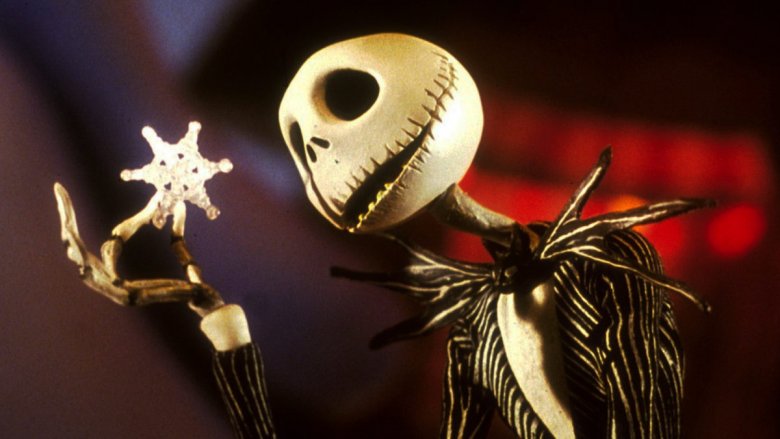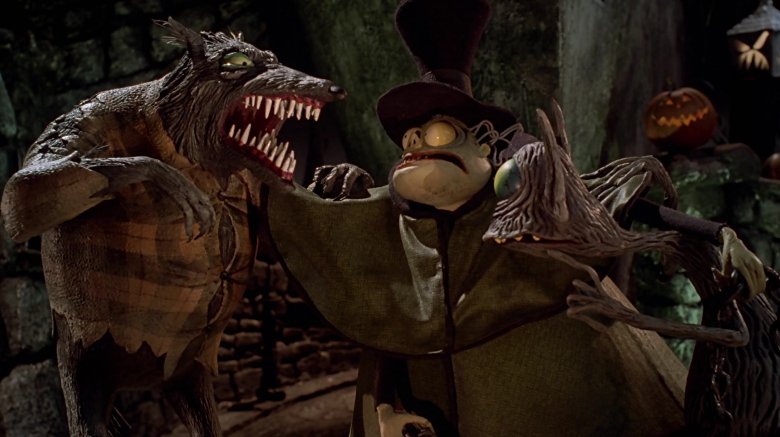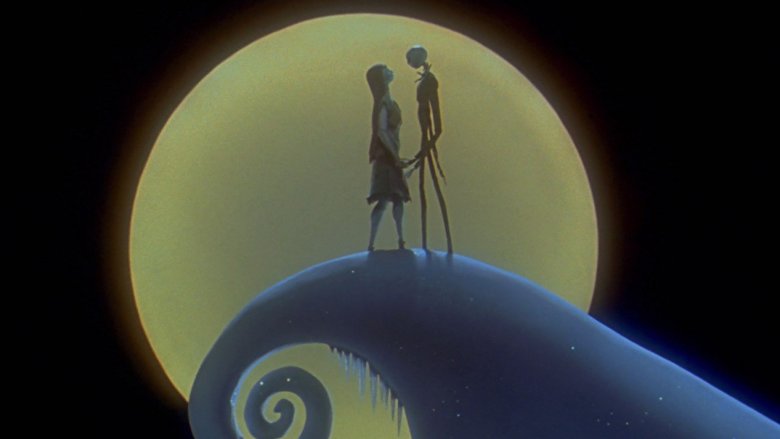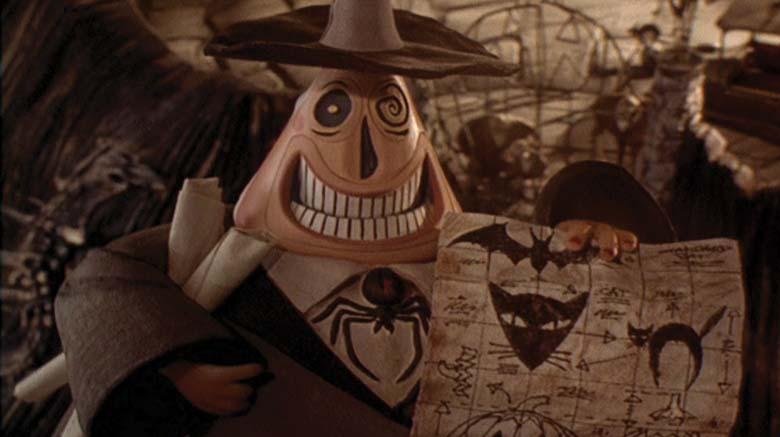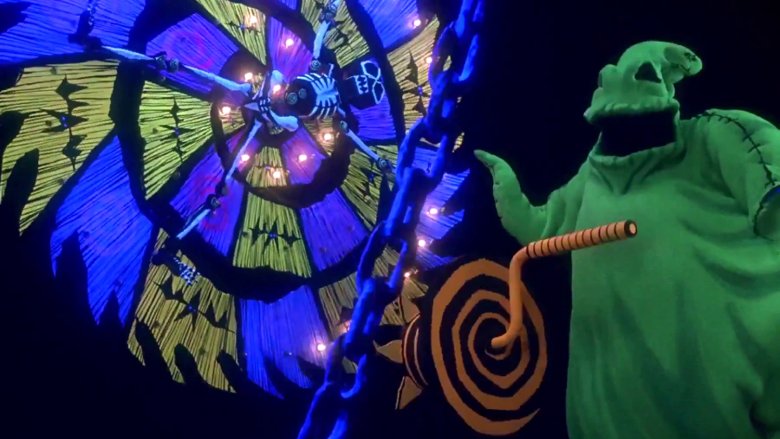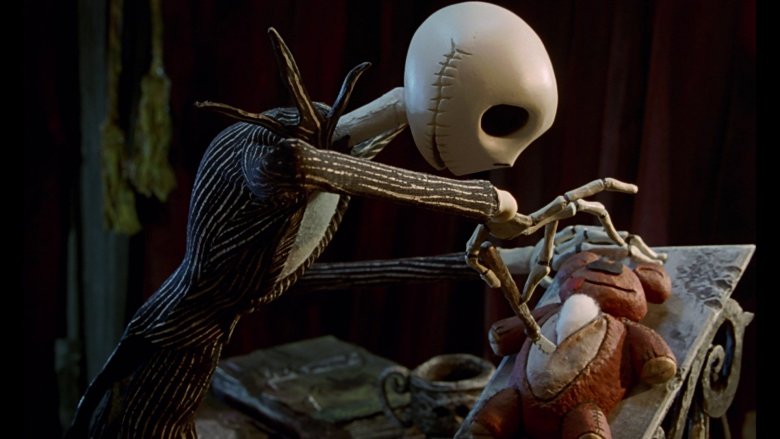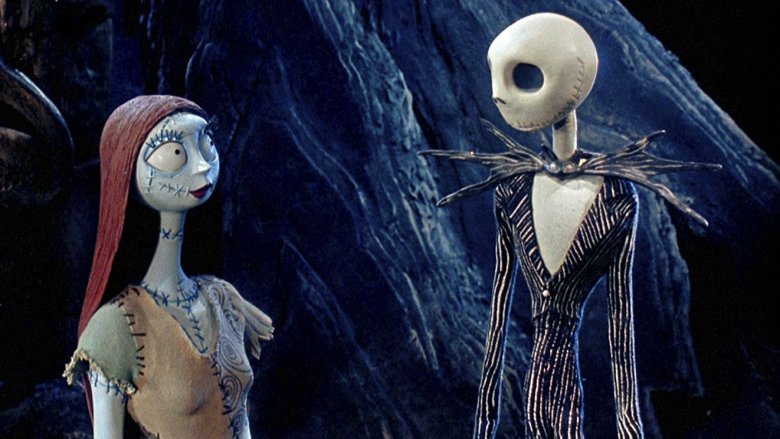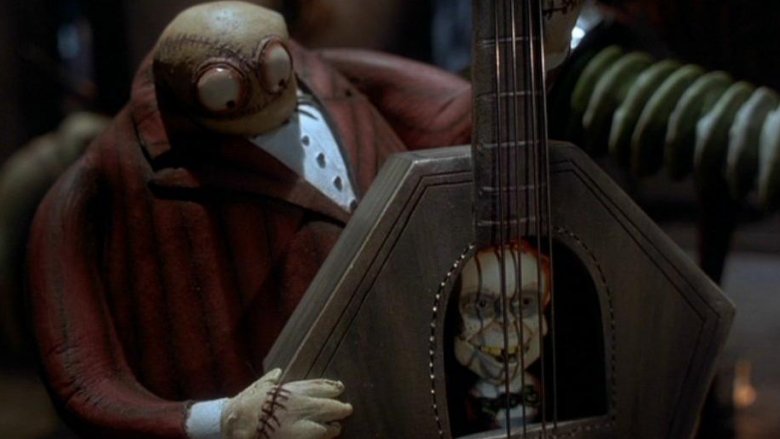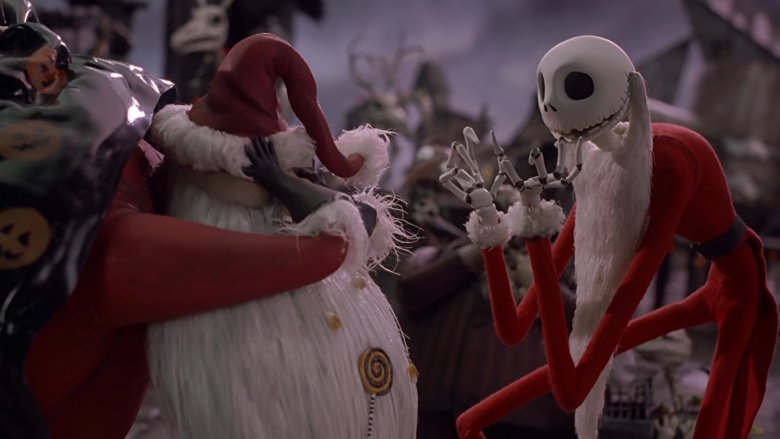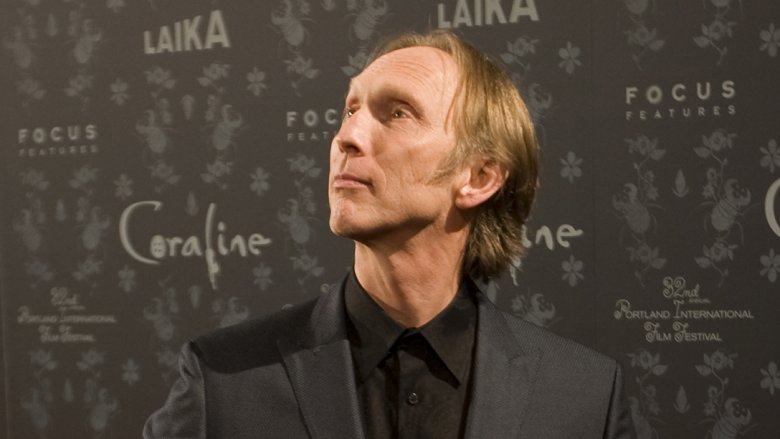Things Only Adults Notice In The Nightmare Before Christmas
As autumn approaches every year, the question resurfaces: Is The Nightmare Before Christmas a Halloween movie or a Christmas movie? Since its theatrical debut in 1993, the stylish, spooky fun of the film has inspired viewers of all ages to indulge in the shameless excitement that the holidays bring, from bonfires, jack-o-lanterns, and sugar highs all the way through to gingerbread, snowmen, and stockings.
Many young adults who grew up with The Nightmare Before Christmas revisit it year after year, reliving that nostalgic joy and noticing things that probably passed them by when the film was still brand new and they were watching with younger eyes. And with the increase in awareness comes the realization that the story has a lot to say beyond its holiday theme — and that ideally, it should be enjoyed from October right through December. With that in mind, here's a look at things only adults notice in The Nightmare Before Christmas.
Honoring the monsters who came before
It's no secret that Nightmare Before Christmas writer and producer Tim Burton is a huge fan of classic monster films and various other oddities of old cinema. In 1982, he directed the animated short Vincent, in which a young boy dreams of becoming like his idol, the beloved classic horror master Vincent Price (who narrates the film). Shortly after, Burton directed the live-action stop-motion short Frankenweenie, which would be expanded as a full-length animated feature in 2012. In both versions, a boy named Victor Frankenstein (his name taken directly from Mary Shelley's original Frankenstein novel) resurrects his beloved pet dog. This love of monsters of movies past comes through loud and clear in the Halloweentown setting of The Nightmare Before Christmas, where the entire populace is monstrous in appearance and fun-loving by nature.
Very young audiences might understand through cultural osmosis that the characters they're seeing are well-known monsters, but it's far more likely that adults will notice that they're frequently references to specific literary and film monsters. Dr. Finkelstein (William Hickey), the mad scientist who created Sally and helps Jack conjure up a skeleton sled team, continues to draw on Burton's penchant for Frankenstein, for example. Other recognizable monster references include Igor, Mr. Hyde (who has multiple versions of himself hiding under his hat), the Wolfman, and the Undersea Gal, who strongly resembles the Creature from the Black Lagoon.
Imbalance in Jack and Sally's relationship
Throughout The Nightmare Before Christmas, viewers are subjected to a mostly one-sided romance in which Sally (Catherine O'Hara), in an endless effort to prove herself to Jack (Chris Sarandon), is continually subjected to his oblivious nature and one-track mind. Obviously children recognize a romance budding here, but it takes an experienced heart to notice that Sally's giving way more than she should for a guy who's so wrapped up in his own problems. Sally's sweet nature and desire to do good are so admirable, and it is a pity in some ways that Jack has to be the one to save the day, because she clearly knew better than him from the very beginning. Sally struggles with feeling acceptance and joy in her life in Halloweentown in much the same way Jack does, but her solution is to try to make connections and help people instead of wandering off and leaving her responsibilities behind. Because this is ostensibly a children's movie, Jack and Sally get together in the end, and it appears as though Jack has begun to understand how his actions (and inactions) have consequences. One hopes that this imbalance in the new lovers' sense of responsibility to each other irons itself out — for Sally's sake.
'I'm only an elected official!'
In many movies for kids, there are jokes for parents littered about. One of the most adult-minded gags in The Nightmare Before Christmas is the character of the Mayor (Glenn Shadix), a squat, two-faced humanoid who's entirely uncertain of how to proceed with just about anything in Halloweentown without assurance from his constituents. Most children don't pay close enough attention to politics to understand what makes the idea of an incompetent mayor quite so funny — and a little bit scary.
The Mayor's smiling public face contrasts with the horror-stricken one on the other side of his head, a conceit that tells the viewer he's performing for the public when he really has a host of fears about how the town is run and his responsibility to keep it running in an efficient manner. When the Mayor approaches Jack's home with plans for the following year's Halloween celebration and Jack doesn't answer his knock, the Mayor cries, concerned face turned frontwards: "Please, Jack! I'm only an elected official, I can't make decisions by myself!" Many adults sitting with their kids during the movie have snorted into their popcorn upon noticing this jab at political bureaucracy.
Oogie Boogie's gambling problem
Much like politics, most child viewers of The Nightmare Before Christmas probably don't have much first-hand experience with gambling and casinos. This is, of course, Oogie Boogie's entire focus, and once Santa Claus (Ed Ivory) is brought into his domain, the references to slot machines, craps games, and roulette abound. When Oogie rolls the dice and announces "Snake eyes!" it's probably safe to say that the kids watching might expect this to be a reference to the tiny twin snakes slithering around Oogie's lair, and not what that roll means from a gambling perspective. Nor would they gain much insight when Oogie bangs on the table to reset the dice to read 11, a much more desirable roll in this context. The scenes in Oogie Boogie's lair are some of the most fun, and Ken Page's performance as the boogeyman is stellar. But it's interesting to notice that in this town where the dreams of childhood Halloween reign supreme, the most feared monster lives in a grown-up world with high stakes that serve only himself.
Jack's midlife crisis
Okay, it's time to just come out and say it — Jack is having a midlife crisis in The Nightmare Before Christmas. He's been the Pumpkin King for far too long and sees himself stuck in a rut. He feels bored with his lot in life, bogged down by too much responsibility. But while most skeletons of his age would go out and buy a new hearse or finally have that steamy affair with the rag doll next door, Jack throws himself into a new obsession, assuming responsibilities that no one has asked him to take on and making a whole lot of mess for his entire town, as well as Christmastown and the world of humans. For children, every day is a new opportunity, and the world is full of mysteries that they have yet to explore. Sure, responsibilities exist in the form of school or household chores, but for the most part, they aren't at risk of reaching a point where they feel completely stagnant in their lives. The crux of The Nightmare Before Christmas is therefore less accessible to them, though they can appreciate that Jack is seeking adventure in some way. For adults, it's far easier to notice the real-life emotions at the heart of Jack's misguided actions.
The complexity of stop-motion
We live in a time when computer-generated graphics have overtaken so much of our film and television experience that it's easy to take special effects for granted. Even in the early '90s, it was not unheard of to use CGI to enhance a film. But The Nightmare Before Christmas is almost entirely hand-sculpted and hand-puppeted, meaning that every single movement and expression is the result of countless takes during which animators changed small physical details in meticulously made renderings of characters and set pieces. The fact that most viewers can ignore this immense amount of work is a tribute to how smoothly the film runs, allowing full immersion for its audience. But there comes a time when adult fans step back and notice that all the minute detail was accomplished through time-consuming, back-breaking work. Each frame required so many hands, so many movements, and so many hours to complete. To anyone with a job, this level of dedication and scrutiny is incredibly impressive.
How well the soundtrack holds up
We all love a good Disney musical. And while The Nightmare Before Christmas is technically one of the studio's pictures (though released under their Touchstone imprint at the time), there's something distinct about the music in this macabre movie. That's entirely thanks to composer Danny Elfman, who has worked with Tim Burton on countless projects. Elfman was the frontman of the new wave band Oingo Boingo from 1979 to 1995, and he brought a lot of that group's energy and lyricism into the Nightmare soundtrack, albeit with a younger audience in mind.
Oingo Boingo (known for a time simply as Boingo) released such hits as "Dead Man's Party," "Weird Science," and even "Tender Lumplings," which many Nightmare fans recognize as a lyric in the film's opening song, "This Is Halloween." With musical themes like these, writing the songs for this movie about a sad skeleton came naturally to the eclectic composer, and Elfman himself provided the singing voice for Jack Skellington. Now not an autumn goes by without the familiar strains of "This Is Halloween" being played at nearly every costume party and on every pumpkin spice enthusiast's personal Facebook page.
A message about cultural exchange
When Jack falls into Christmastown and leaves overwhelmed by his excitement in this new place, he gets the wild idea that he should try to make Christmas his own. Without understanding the first thing about this strange new land, he attempts to engage in research — but without ever asking any inhabitants of Christmastown for their own input or advice. This arrogant need to control that which does not belong to him ends up in disaster, with Jack being shot at as he attempts to spread Christmas cheer throughout the land. It is at this point that he finally realizes he's in way over his head and that he has to try to fix his mistake. When he rescues Santa and Sally and offers his sincere apology, Santa eventually forgives him and even allows him to participate in some of the Christmas joy by showering Halloweentown in a picturesque snowfall.
This exchange is just that: Santa, the person who is immersed in the traditions of Christmastown, has decided to share those traditions with Jack. This is a much more genuine interaction that Jack's attempts to usurp the holiday, and it introduces the good practice of seeking out the advice and ideas of those with more knowledge on a subject before blundering your way through something and mucking it up terribly. Kids might not see that message outright, but adults will notice — and hopefully the nuance sticks with younger viewers as they grow older.
It isn't directed by Tim Burton
It is a common misconception that since Tim Burton wrote the original poem and much of the script for The Nightmare Before Christmas, he also directed it. In fact, a lot of adults might not notice this either, unless they're diehard Burton fans or cinephiles. The film was in fact directed by Henry Selick, making his major feature debut after helming a few shorts. Selick would go on to direct fan favorites like James and the Giant Peach and Coraline, based on great literary works for young readers.
From these films, we can see that even though Burton has a unique visual style that certainly marks The Nightmare Before Christmas, Selick's visual influence is clearly there as well, similar to Burton's but with a unique twist. Burton was evidently only on the set of The Nightmare Before Christmas a handful of times during the multi-year production, and while his influence can't be underestimated, more credit is due to Selick for taking one man's holiday-inspired vision and turning it into stop-motion reality for countless trick-or-treaters to indulge in for years to come.
